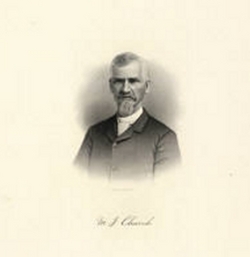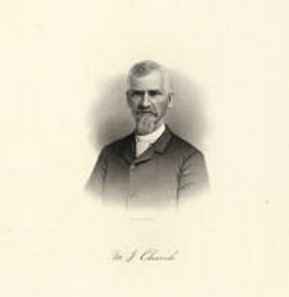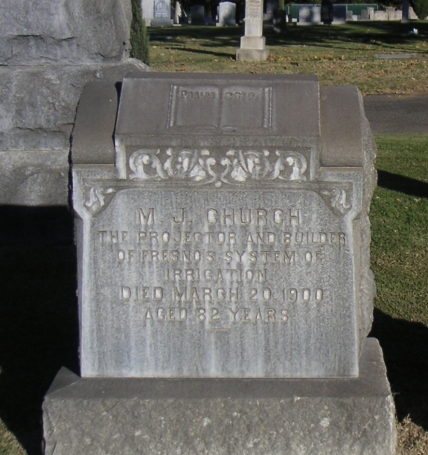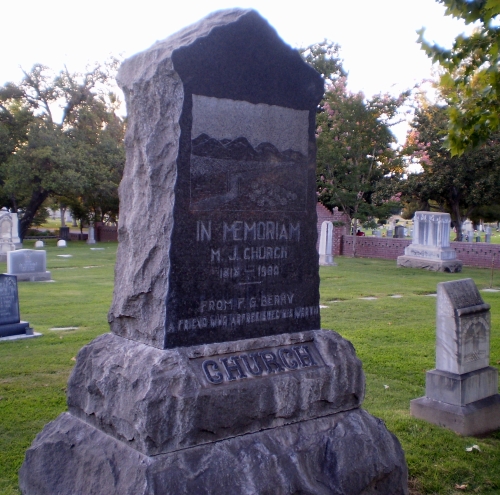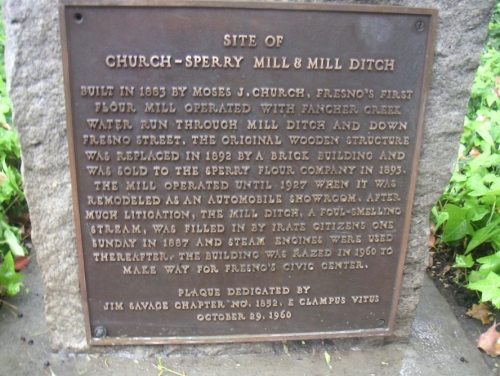His parents, Joshua and Sophronia (Shurtleff) Church, were both of old families of New England, and both natives of Massachusetts. On his father's side his ancestry was Scotch, while on that of his mother he comes of a family distinguished in England as well as America, of which they were among the early settlers at Plymouth. Many of its members have become distinguished in letters and in the sciences, and the name of Shurtleff is today an honored one in the learned professions.
Moses came to California as a Blacksmith in 1852. He moved to what was to eventually become the city of Fresno in 1868. Church developed the first canals, called "Church Ditches," for irrigation in Fresno County. These canals transformed the barren desert of Fresno County into rich soil, thus enabling extensive wheat farming and eventually grape farming in Fresno County.
Uncle of Congressman Denver S. Church, Judge Denver Peckinpah and Great-Uncle of writer, movie director Sam Peckinpah, Church, who raised sheep, was once embroiled in the "Sheep versus Cattle" confrontations with cattle rancher and orange grower "Yank" Hazelton; chronicled in many stories of the Old West in the San Joaquin Valley.
The active and earnest work of Mr. Church and his warm interest in the no-fence law, made him extremely obnoxious to the alarmed and troubled stockmen, and he drew upon himself their special animosity as the instigator of the scheme of irrigation and wheat farming, and as the unflinching leader in favor of the new legislation. Thus aroused, the cattlemen organized to take his life, and three plots were confided to him by members of their own party, and he evaded them.
Suits were then instituted, the plea of these men being that the cattle had the first right to water. Mr. Church, however, defended the farmers' rights to the water, and kept it running. It is safe in saying that in the last twenty years of his life he defended over 200 suits, principally brought about by cattlemen. These were only a few of the difficulties with which Mr. Church had to contend, but his grand scheme of irrigation was successfully carried out, and his canals and ditches exceeded 1,000 miles in the 1890's.
He is justly recognized as the father of the grandest irrigation district in the world. Church is immortalized with not one, not 2, but 3 monuments to his legacy in the city of Fresno, the "Church-Sperry Mills" monument near the Water Tower downtown,the "Moses J Church" Father of Fresno Irrigation monument at the Water Works complex, and the Fulton Berry monument erected to him at Mountain View cemetery.
Early photos of downtown Fresno show the ditches that Church engineered. His methods of irrigation are still studied today.
Another note very important to where his headstone stands today, and where his mortal remains lie, Moses J. Church donated the land for this very Mountain View Cemetery, the entire acreage including the many sub-cemeteries included on the property. One road close by bears his family name. He further ran one of his canals out to the cemeteries in the late 1800's to provide water for the beautiful lawns and trees that grew then and now.
Fresno’s fledgling Armenian community, represented by K.P. Peters, M. Marcarian, and S. Keshishyan, purchased a small portion of Church’s cemetery property for the sum of one dollar in gold coins on December 2, 1885, thus Ararat Cemetery came into being.
A true pioneer of Fresno county.
United States Census, 1880
Moses J Church Head
birth: 1819
New York, United States
residence: 1880
Fresno, Fresno, California, United States
spouse: Sarah Church
child:Dawsey Leonora Church
California Great Registers, 1866-1910
Moses James Church
birth: 1819 New York
other: 12 September 1892
Fresno No 1, Fresno, California, United States
His parents, Joshua and Sophronia (Shurtleff) Church, were both of old families of New England, and both natives of Massachusetts. On his father's side his ancestry was Scotch, while on that of his mother he comes of a family distinguished in England as well as America, of which they were among the early settlers at Plymouth. Many of its members have become distinguished in letters and in the sciences, and the name of Shurtleff is today an honored one in the learned professions.
Moses came to California as a Blacksmith in 1852. He moved to what was to eventually become the city of Fresno in 1868. Church developed the first canals, called "Church Ditches," for irrigation in Fresno County. These canals transformed the barren desert of Fresno County into rich soil, thus enabling extensive wheat farming and eventually grape farming in Fresno County.
Uncle of Congressman Denver S. Church, Judge Denver Peckinpah and Great-Uncle of writer, movie director Sam Peckinpah, Church, who raised sheep, was once embroiled in the "Sheep versus Cattle" confrontations with cattle rancher and orange grower "Yank" Hazelton; chronicled in many stories of the Old West in the San Joaquin Valley.
The active and earnest work of Mr. Church and his warm interest in the no-fence law, made him extremely obnoxious to the alarmed and troubled stockmen, and he drew upon himself their special animosity as the instigator of the scheme of irrigation and wheat farming, and as the unflinching leader in favor of the new legislation. Thus aroused, the cattlemen organized to take his life, and three plots were confided to him by members of their own party, and he evaded them.
Suits were then instituted, the plea of these men being that the cattle had the first right to water. Mr. Church, however, defended the farmers' rights to the water, and kept it running. It is safe in saying that in the last twenty years of his life he defended over 200 suits, principally brought about by cattlemen. These were only a few of the difficulties with which Mr. Church had to contend, but his grand scheme of irrigation was successfully carried out, and his canals and ditches exceeded 1,000 miles in the 1890's.
He is justly recognized as the father of the grandest irrigation district in the world. Church is immortalized with not one, not 2, but 3 monuments to his legacy in the city of Fresno, the "Church-Sperry Mills" monument near the Water Tower downtown,the "Moses J Church" Father of Fresno Irrigation monument at the Water Works complex, and the Fulton Berry monument erected to him at Mountain View cemetery.
Early photos of downtown Fresno show the ditches that Church engineered. His methods of irrigation are still studied today.
Another note very important to where his headstone stands today, and where his mortal remains lie, Moses J. Church donated the land for this very Mountain View Cemetery, the entire acreage including the many sub-cemeteries included on the property. One road close by bears his family name. He further ran one of his canals out to the cemeteries in the late 1800's to provide water for the beautiful lawns and trees that grew then and now.
Fresno’s fledgling Armenian community, represented by K.P. Peters, M. Marcarian, and S. Keshishyan, purchased a small portion of Church’s cemetery property for the sum of one dollar in gold coins on December 2, 1885, thus Ararat Cemetery came into being.
A true pioneer of Fresno county.
United States Census, 1880
Moses J Church Head
birth: 1819
New York, United States
residence: 1880
Fresno, Fresno, California, United States
spouse: Sarah Church
child:Dawsey Leonora Church
California Great Registers, 1866-1910
Moses James Church
birth: 1819 New York
other: 12 September 1892
Fresno No 1, Fresno, California, United States
Gravesite Details
Middle name is either James or Joshua, both names show up in historical documents.
Family Members
Sponsored by Ancestry
Advertisement
Explore more
Sponsored by Ancestry
Advertisement
